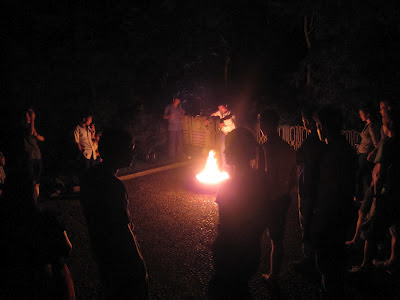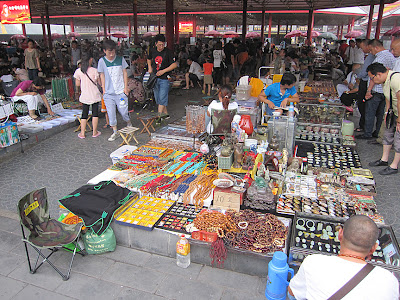I arrive at the airport and hand my cell phone over to an unsmiling customs agent (I’ll get it back in a week - I hope). Three hours later, I’m standing on a quiet road, pissing in a cornfield under a full moon. Tonight I will join a group of fellow travelers to watch a pile of clams get doused with gasoline and set on fire. We'll smash the shells against cobblestone, gobble up the innards, and swap swigs of Soju to kill any bugs that survive the flames. Reeling crazily along an unlit road, I will somehow get into bed and prepare for the days to come. I’m in North Korea, spending a week in the so-called Hermit Kingdom, and I have no idea what to expect.
In this blog I’ll sketch out some details about our week in this fascinating, frustrating, odd, and strangely familiar place. These notes reflect one tourist’s experience and must be understood as being shaped by the strict limitations that North Korea places upon what visitors can see and experience. My notes cannot reflect meaningfully upon issues related to human rights or famine or the proclivities of North Korea’s leaders. All I can do is share something about what I saw and heard, offering a perspective on how North Korea works to define its image by carefully crafting what it shows to outsiders.
 |
| Mural beside Kim Il Sung stadium |
We arrived in Pyongyang in late afternoon via Air Koryo, an airline whose planes aren’t considered safe enough to fly in Europe. Ours was OK though. It’s one of the newer ones. While we taxied on the runway, the cabin swelled with a florid combination of jingo march and ‘80s synth you might hear in Hell’s karaoke lounge. People in uniform stood at attention around the tarmac. Some stared at us. Some stared at the runway. And across wide expanses, some stared at each other.
 |
| Arriving via Air Koryo |
The guy scrutinized my paperwork and then told me to stand nearby, not here but somewhere over there. Yes, there. Well, no. Actually, there. Getting past this guy wouldn’t be easy. Other uniformed officials gathered closer as tiny drops of sweat began to pop on the back of my neck. That’s when a young woman approached and began to chat with the agent. A moment later he was bagging my phones and preparing a receipt.
“I’m your guide,” the woman explained.
I smiled with relief, thinking to myself, "You point; I’ll walk."
Dragonflies coasted on humid currents as I joined my group – 19 tourists, including two other Americans – visiting this country for the first time. Ours was a convivial, eclectic community, including a British couple and their two impossibly well-behaved children (aged 4 and 6), a 19-year-old college student working in Hong Kong, and a married couple who travel the world consulting national governments on procurement strategies.
We’d selected Koryo Tours, an outfit with two decades of experience bringing tourists to the DPRK, to guide us. We all performed our identities as seasoned travelers (I uttered banalities like, “Oh, you’ve got to drive along the Australian coast” and “We just loved Prague. It’s our favorite Central European city!”).
We all talked like that, trying to affect an air of experience, but our group was universally and frankly excited. Just a few more minutes and we’d be driving through Pyongyang toward Nampho. 30 miles away we’d be cracking those gas-fire clams and taking mineral baths. Our North Korean adventure was so close!
 |
| Poster for Sea of Blood, a revolutionary opera |
We began by rattling down a long stretch of cracked pavement that led us to a network of rocky traces and dirt paths stretching away from the DPRK’s showcase capital. For nearly an hour and a half, we had the roads pretty much to ourselves. We passed a handful of other buses, a few trucks too. Once we saw a loudspeaker-van broken down by the roadside, but we saw almost no cars. Mostly we saw farmers and children, sometimes walking, sometimes squatting alongside the road. A few waved and smiled at us. Some scowled. Most just stared.
We’d been on the road for nearly an hour and a half when, mere minutes from our destination, we learned that the bridge up ahead had been washed out. It was monsoon season and the rains had been brutal. We’d have to turn around and retrace much of our route, driving once more through Pyongyang. That meant another hour and a half on that rutted road. Few of us cared about Nampho’s famed mineral baths at this point; we were getting cranky. That’s when someone asked about taking a potty break.
A few of us got off the bus, milling around out of boredom more than anything. We saw rolling hills and distant mountains, muted browns and drab greens, and nothing that looked like a bathroom. A guide offered a sensible enough solution, diverting our attention to the nearby cornfield. “You can use nature!” A few of us laughed nervously, but she wasn’t kidding. The sun had set and we had no other options.
I trudged through mucky earth to stand by David Terry, a pal who’d traveled with me from California to Beijing to here, overhauling his finances to pay for this trip. I wondered if he was beginning to regret his decision, but the time for doubt had passed.
"We’re in the DPRK now, dude!"
I looked around, unzipped my fly, and sprinkled my greetings.
Pissing in a North Korean cornfield was certainly not on anyone’s itinerary, but the moment offered us a glimpse into just how complex this trip would get. For all of the stories we’d heard about the DPRK’s obsession with managing the movement of outsiders, we were going to see at least a few cracks in that country’s carefully staged façade.
 |
| Back stage and front stage |
I could not imagine what was coming. I only knew that David and I would travel with our group until Saturday, seeing Pyongyang and visiting a few more distant sites; then we’d continue independently for another three days (always with North Korean guides, of course), with an itinerary that had never been formally completed. Seven days in the DPRK: Anything could happen.
 |
| Sharing petrol clams in North Korea |






















